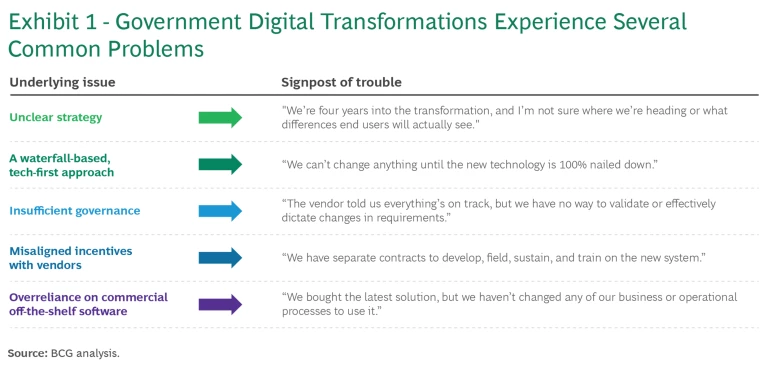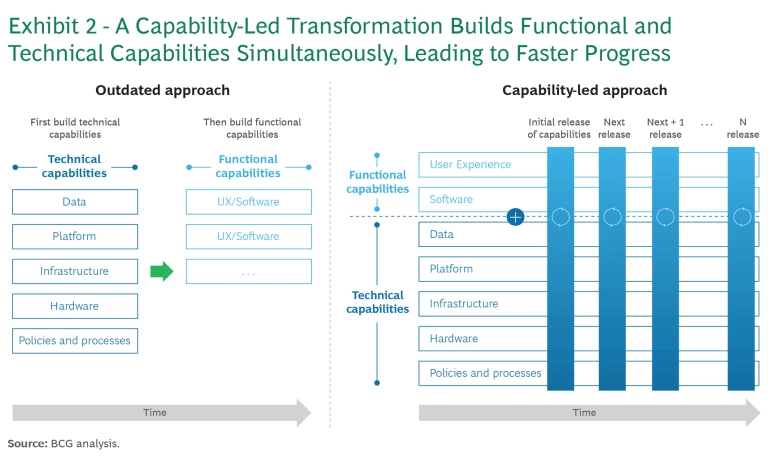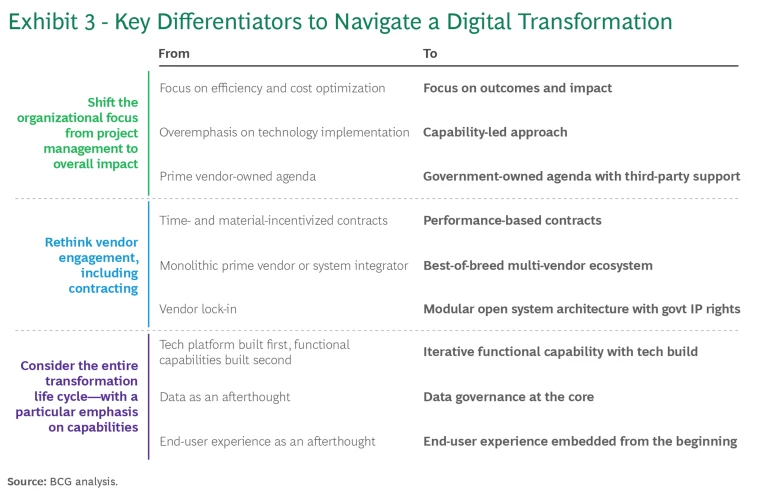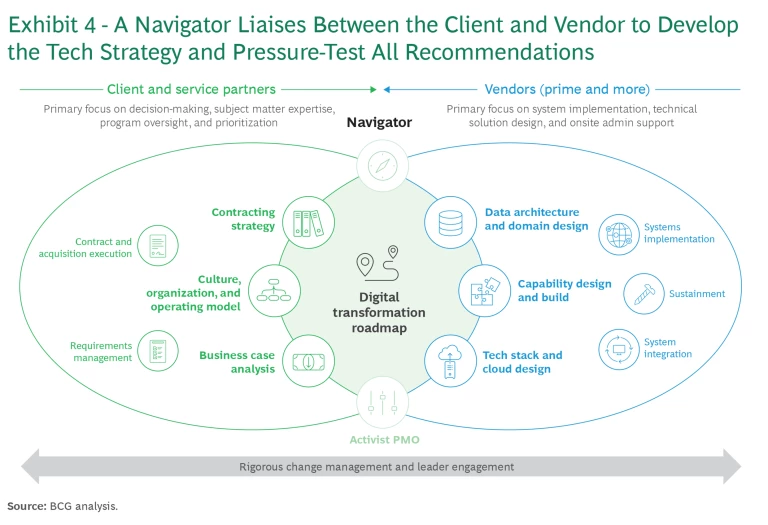US government agencies continually struggle to execute digital transformations. Programs frequently run over budget and over schedule. Worse, after spending billions of dollars on multi-year programs, agencies (both civilian and defense) often end up with limited gains at best, and no meaningful change in capabilities. This approach is no longer sustainable. Instead, the government must rethink its approach to digital transformations.
Some public sector organizations have taken steps to improve, such as creating a flexible technology architecture, working in more agile ways, and being more transparent about program status. However, those measures—while important—are becoming table stakes. Governments also need to take a capability-led approach to transformation by focusing on the ultimate goals they are seeking to achieve. Differentiators such as shifting the mindset from project management to overall impact, rethinking contractor and vendor management to enforce accountability for outcomes, and planning for the overall transformation life cycle from the start can all help governments build capabilities more effectively in transformations.
Moreover, governments require a new role to enable those differentiators: an unbiased, third-party navigator that can serve as a trusted advisor and liaise between the government and the prime vendors and system integrators that it hires. In our experience, governments that use a navigator to help implement the differentiators can flip the odds of a transformation dramatically in their favor and capture the full potential value of a transformation. In that way, they can keep large-scale change initiatives within budget and on schedule, emerge with stronger capabilities, and better equip themselves to accomplish their mission.
The Growing Digitization Imperative
The US government has a growing imperative to digitize and modernize. Core systems at many agencies are becoming obsolete, and regulatory requirements are growing. At the same time, new solutions can help organizations dramatically improve their performance through data-driven insights, even as citizens’ expectations are growing for a more intuitive customer experience.
When executed well, digitization can lead to dramatic advances in government services in areas such as improving health care patient outcomes and creating a more intuitive and customer-friendly experience for taxpayers and constituents. Internally, digitization can improve capabilities, streamline back-end processing functions, boost efficiency, and make data more accessible to the government leaders and employees who protect and serve our nation.
That said,
digital transformations
are large, complex programs that frequently fall short of their objectives. Among both public and private sector initiatives:
- only 35% of large transformations succeed within timeline and budget;
- 98% of large transformations face unforeseen implementation difficulties, leading to scope creep and additional requirements; and
- programs can take five to eight years before they begin generating financial value—a lifetime given how fast digital technology advances.
Based on our experience supporting government transformations over the past ten+ years, BCG has determined that there are several underlying issues that cause large-scale digital transformations in government agencies to go off-track. These include a waterfall-based, tech-first approach, insufficient governance, and an unclear strategy, among others. (See Exhibit 1.)

Table-Stakes Measures to Improve Digital Transformation
Our experience also points to the following table-stakes measures government organizations can implement to make digital transformations more successful. These measures are not new, but in our experience, many government agencies still don’t put them into practice:
- Build a flexible, extensible technology architecture. Emphasize flexibility, adaptation, and scalability. A digital and data platform can standardize core transactional systems and data platforms, and separate data from individual applications or systems.
- Adopt agile ways of working. Focus on iterative development through sprint cycles and quick value delivery, using DevSecOps and collaboration tooling to enable speed.
- Make transformation progress more transparent. Both stakeholders in government agencies and vendors must have access to a baseline of information—both processes and data—to make informed decisions and ensure that vendors are accountable.
At many government organizations, these measures would lead to significant progress. But they’re not enough to execute a digital transformation effectively, on time, and within budget.
Putting New Capabilities at the Center of the Effort
In addition to table-stakes measures, government entities should ensure that a transformation achieves its main objective: building new capabilities for an organization. Rather than a linear, gated process, this often means an iterative approach that addresses people, processes, tech, data, and systems simultaneously to build capabilities incrementally over time. (See Exhibit 2.)

Three differentiators can help government organizations take a capability-led approach to transformation. (See Exhibit 3.)

Shifting the organizational focus from project management to overall impact. Putting the government in control of an overall program ensures that big-picture objectives and capabilities remain the primary focus. Rather than transforming simply to reduce costs and increase efficiency, agencies can focus on broader and more impactful goals, treating the transformation as an opportunity to rethink what is possible for an organization.
This approach, grounded in clear, centrally agreed-upon metrics for the transformation that align with strategic goals and desired outcomes, extends to governance as well. Metrics should be both holistic enough to reflect overall performance and limited to a discrete number that can be maintained in near real time. Collaboration across departments and vendors should be encouraged for better decision-making.
Rethinking vendor engagement, including contracting. Traditional government contracts can often create the wrong incentives. Instead, agencies should shift to contracts that both reward performance and outcomes and are tied to the achievement of specific program milestones.
Rather than relying entirely on a system integrator or prime contractor, government organizations can create a best-of-breed, multi-vendor ecosystem. This approach allows an organization to optimize skill sets by selecting niche vendors to support the system integrator or prime vendor in implementing technology. To be clear, this approach requires the government to have stronger capabilities in program and vendor management.
Vendor incentives should support the creation of a modular, open system architecture that is flexible enough for subsequent add-ons. Equally important, the government should retain rights to the code and data, along with control over the technology ecosystem, to avoid getting locked into a specific vendor. Prioritizing data governance from the start supports the integration of solutions upon delivery and into sustainment.
Consider the entire transformation life cycle—with a particular emphasis on capabilities. Rather than waiting for a complete solution to be in place, government customers should build capabilities iteratively and in parallel with the development of a tech platform—an approach that leads to continuous delivery of value. Similarly, governments should embed the end-user experience into a transformation from the start, incorporating feedback from real-world users during the design and testing phase.
Leading organizations plan for the full life cycle of a transformation, from development through sustainment, to ensure long-term viability. They also shift from isolated assessments of individual use cases to a holistic, portfolio-driven strategy that factors in the scalability of a platform and underling capabilities. And top performers consider programmatic requirements—including funding—that are needed to scale pilots and proofs of concept through to full implementation. For example, flexible contracts and funding models support on-demand fielding of new capabilities, updates, and enhancements to systems.
The Power of a Navigator
In many cases, we’ve seen the government leverage an objective third party—a navigator—to enable the differentiators above and help implement a digital transformation. A navigator isn’t an individual, but rather a team of product managers, IT architects, program-specific subject matter experts, and user-experience designers. Collectively, this group serves as a trusted advisor to the government and as a liaison with vendors, bringing the right stakeholders to the right conversations at the right time to ensure better outcomes. (See Exhibit 4.)

This is a flexible approach that can benefit government transformations at all stages and objectives. For new programs, a navigator can define a business case, shape the roadmap, and support vendor negotiations to get the best deal. For programs already underway, a navigator can get timelines back on track, support executional certainty, and make changes sustainable over time. (See “Critical Questions for Government Leaders.”)
CRITICAL QUESTIONS FOR GOVERNMENT LEADERS
- Where are we in our transformation journey? Is this a new system, or are we upgrading an existing capability or platform?
- If we’ve already started, are we on schedule and on budget?
- Do we own the transformation agenda?
- Is the program designed to meet the evolving capability needs of stakeholders?
- What is our current spend and ROI to date?
- Where do we see inefficiencies, areas for improvement, and gaps in capability or communication?
- Are our vendors meeting performance expectations as laid out in service-level agreements or contracts?
- Could we benefit from expanding our vendor base?
- Are we attuned to all potential risks from the transformation?
Specific responsibilities of the navigator include the following:
Creating the business case, strategy, and roadmap
- Identifying and championing the government’s highest-value priorities
- Managing stakeholders and serving as a thought partner to leadership teams
Developing the technology platform and data governance
- Determining technology architecture, developing requirements, deciding on key design elements, and prioritizing use cases
- Pressure-testing product vendor and system integrator recommendations against business objectives and external best practices
Overseeing governance and execution
- Enabling and accelerating the standup of governance bodies, transformation roadmaps, and other deliverables
- Creating transparency, ownership, and alignment across all stakeholders to deliver government’s mission
- Providing strategic guidance including industry, architecture design, and change management expertise
- Driving design and execution of solutions to advance broader transformation goals without impacting any ongoing enterprise initiatives or strategic priorities
In our experience, combining the differentiators discussed above with a neutral, third-party navigator can deliver a significant ROI on government digital transformations, including the following:
- 40% faster path to value from new capabilities
- 35% reduction of project scope
- 70% increased degree of standardization
- 35% higher transformation success rate
- 30- to 60-fold return from investing 5% of program budget in de-risking
Governments face a growing imperative for digital transformation, but these programs are expensive, complex, and time-consuming. Without the right approach, governments can spend millions of dollars and end up with new technology that doesn’t meet their needs, alienates users, and leaves an organization further behind than when it started.
Conversely, governments that take a proactive approach—applying the differentiators we identified and relying on an objective, third-party navigator—can ensure that their digital transformation stays on schedule and on budget and leads to strong capabilities. In that way, they can better position themselves to meet the needs of their stakeholders.













